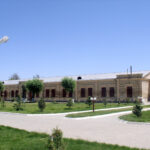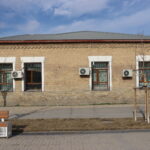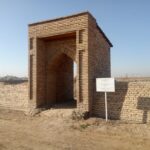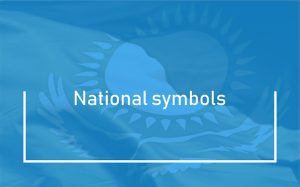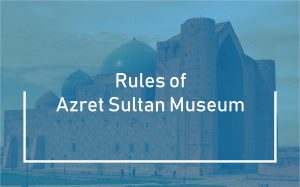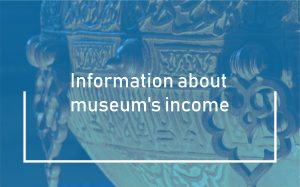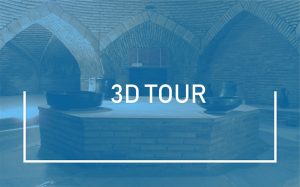Nurbolat Akhmetzhanov, more than three years leading the state historical and cultural reserve-museum «Azret Sultan», met with the staff of the museum-reserve and expressed his gratitude in connection with the transition to another position.
In this regard, the Vice-Minister of Culture and Sports Nurgissa Daueshov also paid a special visit to Turkestan, the staff presented letters of gratitude and gifts.
— “Working in the conditions of a real historical renovation of the city of Turkestan, you have also contributed to the revival and development of the museum-reserve. The scientific and educational project “In the footsteps of Yassawi” initiated by you and the publication of information in honor of the people buried in the mausoleum were performed at a very high level. We sincerely thank you on behalf of the Minister, the Ministry and wish you a positive momentum in your new position!” — said Nurgissa Muratovich.
Nurbolat Kadyrovich, a competent manager, who devoted his career to the development of culture, thanked the hard-working team and wished them success in their future endeavors.
In turn, the staff of the reserve-museum said goodbye to a caring and experienced leader who supported them in their work, raised them to great heights and always showed compassion.
It is worth noting that on September 5, 2017, Akhmetzhanov Nurbolat Kadyrovich was appointed director of the state historical and cultural reserve-museum “Azret Sultan” in Turkestan. During these years he worked hard on the creation of the museum-reserve “Azret Sultan”.
For three years he focused on the study of the heritage of Khoja Akhmed Yassawi and raised it to an international level.
Seven conferences of national and international level were organized, historians and scholars of the Turkic world read reports and issued special booklets.
More than 260 exhibitions were organized to promote the Khoja Akhmed Yassawi Mausoleum and Turkestan, the people buried in and around the mausoleum, seven of which were held abroad, in Kastamonu, Ankara, Bursa, Turkey, Sochi, Russia, Thessaloniki, Greece and Tashkent, Uzbekistan.
In addition, at the international level an event was organized for the 40th anniversary of the State Historical and Cultural Reserve-Museum «Azret Sultan» to which scientists from Turkey, Cyprus, Russia, Ukraine, Azerbaijan and Uzbekistan were invited.
The encyclopedia “Azret Sultan” was published for the first time in the country. This work contains the most valuable information about Khoja Akhmed Yassawi.
For three years the preserve-museum “Azret Sultan” has published about 20 historical books. Among them are books “Khans and Sultans Buried in Turkestan”, “Kazakh biis buried in Turkestan”, “100 legends” in Kazakh, Russian and English languages, “Ceramic vessels of Turkestan”, “Teriskey tolgaulary”, “Tanybai batyr”, “Jewellery”. Also, there is a directory-book, album-book “40 Years Reserve-Museum Azret Sultan”, a booklet “Mausoleum of Khoja Akhmed Yassawi.
In addition, translated from Chagatai into Kazakh book Khoja Akhmed Yassawi “Diwani Hikmet”, copied in 1842 from the collection of the reserve-museum.
The State Historical and Cultural Reserve-Museum “Azret Sultan” for the first time launched a scientific and educational expedition “In the footsteps of Yassawi” to find new information about Khoja Akhmed Yassawi, to study in depth, to access unexplored historical information. During the expedition a number of data of Khoja Akhmed Yassawi was collected and significant scientific achievements were achieved.
The scientific and educational project «In the Footsteps of Yassawi» focused on data on the parents, grandparents, descendants, and brothers of Khoja Akhmed Yassawi, and conducted research.
In this regard, a copy of the genealogy of the famous Khoja Akhmed Yassawi and the names of eleven famous sheikhs of the Islamic world who spread Sufism were discovered in Namangan, Uzbekistan.
An 800-year-old walking stick and a manuscript belonging to Khoja Akhmed Yassawi’s uncle were found. This legacy has been preserved in the mausoleum of Tagain Ata by a dynasty that has worked as torch-bearers since the time of their ancestors.
Also a unique find was a manuscript and special sealed documents dedicated to the history of Khoja Akhmed Yassawi’s nephew Yussuf Ata. In the process of translating, the valuable heritage of the elder Seydalim Yuldashev, a descendant of Yussuf Ata, which resulted in a lot of information. The 13th century manuscript states that Khoja Akhmed Yassawi’s half-sister, Bibi Khubra, was the mother of Yusuf’s mother. This news was important not only for Kazakhstan but also for the Republic of Turkey. This fact drew the attention of the Ministry of Culture and Tourism of the Republic of Turkey.
During the scientific and educational expedition “In the footsteps of Yassawi” the genealogy of Khoja Akhmed Yassawi was translated and kept in the hands of another generation living in Turkestan, it became known that Jamila was Yassawi’s native daughter and not an adopted one. After a complete translation of the data, the names of Jamila, daughter of Khoja Akhmed Yassawi, and his son Ibrahim Sultan were included in the list of people buried in and around the mausoleum.
The burial place of Ibrahim Sultan’s son was also not overlooked. Earlier, the Azret Sultan Museum-Reserve, which conducted research based on the relevant data, installed a special tombstone around the burial place of Yassawi’s son. The burial place of Ibrahim Sultan, son of Khoja Akhmed Yassawi, was determined, and research into the construction of the mausoleum began.
The data of Yassawi’s brother Sadir Shaiyk and his disciples were also collected.
Historical and cognitive expeditions were organized in Sairam, Suzak, Otyrar districts of Turkestan region, Zhambyl, Kyzylorda regions and the Republic of Uzbekistan. The descendants of the pupils of Khoja Akhmed Yassawi, who were scattered in more than 100 countries, are preparing unpublished data, books and genealogies.
It also turned out that the real name of Akhmet Yassawi Karashash’s mother was Tagaysha Bibi.
Recently a memorandum was signed between the Azret Sultan Museum-Reserve and the Turkish Cooperation and Coordination Agency on the promotion of the Yassawi Trail and the cognitive project in the Turkic world. During bilateral agreements between Nurbolat Kadyrovich and the Agency Representative in Kazakhstan Ismail Gurlek, preservation of historical and cultural heritage, popularization of historical materials found within the research project “In the footsteps of Yassawi”, their presentation for restoration, distribution in the Turkic world. An agreement was reached to implement joint scientific and cultural excursion programs in order to popularize relevant religious and historical monuments, form a tourist image, exchange experiences and improve the skills of specialists in the field of culture, as well as to coordinate activities in related fields.
In addition, the manuscript on the history of Yussup-Ata, dating back to the 13th century, was translated into Turkish and became propaganda to the Turkic world in the form of an electronic book.
The Academic Council approved the historical data of 12 persons and included them to the list of persons buried near the mausoleum of Khoja Akhmed Yassawi.
The Great Aksaray Hall of Akhmet Yassawi Mausoleum, Library Hall, Rabia Sultan Begim Mausoleum, and Uqash Ata History Museum were opened for museum work.
To revive the historical appearance of the mausoleum, memorial plaques are placed on the historical pedestal around the boiler room.
A medieval chandelier is suspended in front of the tomb of Khoja Akhmed Yassawi.
The medieval historical well inside the mausoleum of Khoja Akhmed Yassawi has been commissioned and handed over for the benefit of the country.
The territory of mausoleums of Ukasha Ata, Gauhar Ana, Zhussup Ata and Alkoja Ata has been improved.
The issue of providing clean drinking water, watering and planting willows and flowers for visitors to the Uqasha Ata mausoleum was resolved. With the support of sponsors, a 40-meter artesian well was dug near the Ukasha Ata mausoleum at a cost of 5,000,000 tenge. In addition, the well was paved and landscaped.
Lighting was provided to the parking lot near the mausoleum and the Ukasha Ata well. Rest areas for pilgrims were arranged, and the road to the sacred well was asphalted.
In accordance with the development plan for 2018-2021, adopted by the RSE «State Historical and Cultural Reserve-Museum “Azret Sultan”, work on the improvement of historical monuments, quality service to tourists and pilgrims and for three years attracted more than 200 million from sponsors.
The museum is also building a tourist center under the Zhussup Ata mausoleum, and the Zhussup Ata Garden was created in accordance with its historical appearance, and the best varieties of grapes were planted.
The lamps from Akhmet Yassawi’s mausoleum, taken away in 1906, were returned to the museum, one of which was kept in the Louvre in France and the other two were kept in the Hermitage in Russia.
Two projects of the Ministry of Culture and Sports of the Republic of Kazakhstan received grants from the contest of scientific projects: “Comprehensive study of the socio-economic and cultural history of Turkestan of the mid XIX — early XXI centuries” and “History of underground mosques of Kazakhstan and the museum “Underground mosque Kyluet”.


